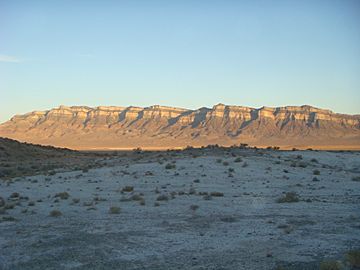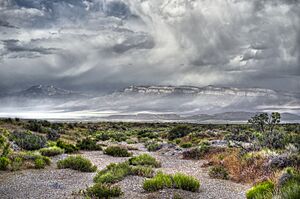House Range facts for kids
Quick facts for kids House Range |
|
|---|---|

Northern part of the House Range at sunset-(Swasey Mountain section), showing the stratigraphy
|
|
| Highest point | |
| Peak | Swasey Peak |
| Elevation | 9,669 ft (2,947 m) |
| Dimensions | |
| Length | 70 mi (110 km) N/S |
| Width | 34 mi (55 km) E/W |
| Area | 1,242 sq mi (3,220 km2) |
| Geography | |
| Country | United States |
| State | Millard County, Utah |

The House Range is a mountain range in Millard County, located in west-central Utah. It runs from north to south. This range got its name in 1859 from a man named James H. Simpson. He named it because its rocks looked like they were built in layers, and some parts of the mountains looked like houses, domes, or tall towers.
Contents
Exploring the House Range
The House Range is surrounded by different valleys. To the west, you'll find Tule Valley. To the east, there's Whirlwind Valley and the Sevier Desert. To the north, it connects with the Fish Springs Range.
Mountain Passes
There are three important passes that cut through the House Range. Skull Rock Pass is used by US Highway 6 and US Highway 50. The older US Highway 6 goes through Marjum Canyon. Finally, the Weiss Highway uses Sand Pass.
Notable Peaks
The highest point in the House Range is Swasey Peak, which stands at 9,669 feet (2,947 meters) tall. Another famous spot is Notch Peak. It's known for being a great place for climbing and even base-jumping! The range also has a very unique, square-shaped mountain called Tatow Knob.
Tall Cliffs
The House Range is home to one of the tallest limestone cliffs in the world, also found at Notch Peak. Limestone is a type of rock that often forms in clear, warm waters.
The Rocks and Land of the House Range
The House Range is mostly made of gray carbonate rock. These rocks formed a very long time ago, between the Cambrian and Devonian periods. In the middle of the range, you can also find pink granitoid rock from the Jurassic period.
Ancient Lake Bonneville
You can find signs of an ancient lake called Lake Bonneville at the bottom of the House Range. This huge lake once covered much of Utah. You can see old shorelines and white marls (a type of soil) left behind by the lake.
Amazing Fossils
The House Range is famous for its incredible fossils. It has a special place called a Lagerstätte (pronounced "LAH-ger-shtaht-uh"). This is a German word for a place where many fossils are found in excellent condition. The fossils here are from the Cambrian age.
Trilobites and Other Ancient Creatures
Many of the fossils found here are similar to those from the famous Burgess Shale in Canada. One of the most well-known fossils from the House Range is Elrathia kingii. This is a type of trilobite, which was a small, hard-shelled sea creature that lived hundreds of millions of years ago. Elrathia kingii is one of Utah's most famous fossils!
Layers of Time
The rocks in the House Range show different layers of time. The Swasey Limestone formed during a time known as the Bathyuriscus–Elrathina trilobite zone. Above this, you find the Wheeler Shale and Marjum Formation, which contain fossils from the Bolaspidella zone. Finally, the Weeks Formation is from the Cedaria zone. Each zone represents a different period in Earth's ancient history.


